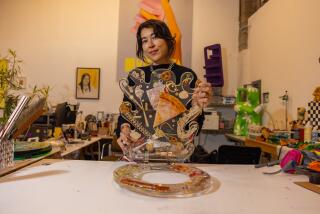To some, it’s a toilet seat; to this artist, it’s a canvas
- Share via
SAN ANTONIO — Barney Smith does not know where his wife’s gallstones are. He knows they were extracted a few years ago, and he thinks they float in a jar of murky liquid somewhere in the Smiths’ home. But his wife, Velma Louise, won’t say a word about their location.
“She’s got them hid in the house,” Smith said. “She knew where they’d wind up whenever I ran across them.”
The elusive gallstones, Smith explained, would have ended up affixed to a toilet seat lid titled “Surgery,” one of hundreds of such lids the 82-year-old has adorned and hung in his corrugated metal garage -- or, as Smith has christened it, his Toilet Seat Art Museum.
Since retiring as a plumber 32 years ago, Smith has produced 677 of the fanciful seats, which now pack the museum’s walls from floor to ceiling. The work has placed him at the forefront of the lonely field of toilet seat art and made the museum, in its quiet residential neighborhood, a far-off-the-roadside attraction that draws about 1,000 curious visitors each year.
Smith, who is small, white-haired and garrulous, has a pat answer for those who wonder why he chose toilet seats as his canvas.
“Since I was a master plumber, I wanted to stick with my trade,” he said.
With evident pride and strikingly deadpan delivery, Smith shows guests around the cramped garage, telling stories about the seats he has engraved, painted, stuck junk to and numbered.
There’s the “Stop Drugs, Say No” seat, complete with a real marijuana leaf that Smith found on a plumbing job several years ago -- and, on the back, permission from the San Antonio Police Department to use the leaf “for educational purposes.”
Nearby hangs the “Surgery” seat, on which Smith adhered IV bags, a hospital identification bracelet and a photo of his wife on a gurney. At the rear of the museum, a seat called “1921-1931” is covered with marbles from Smith’s childhood.
“Whenever they say, ‘Have you lost your marbles?’ ” Smith said, “I say, ‘No, I’ve got them on my toilet seat.’ ”
Other seats display trading cards, plumbing supplies, stones and souvenirs from the Smiths’ travels to Hawaii, Eastern Europe, Israel and elsewhere. On the back of the seats, which are given to Smith by a local plumbing supplier, he paints a number and engraves the names of those who contributed materials for the seat.
Smith quietly practiced his art for two decades and had reached No. 127 when he held a garage sale in 1992. One customer, an artist, took to Smith’s landscape paintings and asked to see more. Smith led him into the garage, where the customer spied the seats. Impressed, the artist alerted a local television station, which aired a segment about Smith. Visitors followed, and the museum was born.
Smith has since opened his garage doors to onlookers from all 50 states and 54 countries. He charges no admission and says he has refused many offers to buy his creations.
More to Read
The biggest entertainment stories
Get our big stories about Hollywood, film, television, music, arts, culture and more right in your inbox as soon as they publish.
You may occasionally receive promotional content from the Los Angeles Times.










